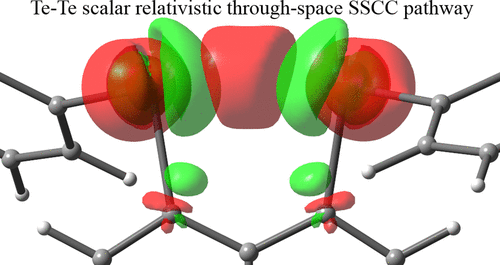当前位置:
X-MOL 学术
›
J. Phys. Chem. A
›
论文详情
Our official English website, www.x-mol.net, welcomes your
feedback! (Note: you will need to create a separate account there.)
NMR Spin-Spin Coupling Constants Derived from Relativistic Four-Component DFT Theory-Analysis and Visualization.
The Journal of Physical Chemistry A ( IF 2.7 ) Pub Date : 2020-05-27 , DOI: 10.1021/acs.jpca.0c02807 Stanislav Komorovsky 1 , Katarzyna Jakubowska 2 , Paweł Świder 3 , Michal Repisky 4 , Michał Jaszuński 3
The Journal of Physical Chemistry A ( IF 2.7 ) Pub Date : 2020-05-27 , DOI: 10.1021/acs.jpca.0c02807 Stanislav Komorovsky 1 , Katarzyna Jakubowska 2 , Paweł Świder 3 , Michal Repisky 4 , Michał Jaszuński 3
Affiliation

|
An unambiguous assignment of coupling pathways plays an important role in the description and rationalization of NMR indirect spin–spin coupling constants (SSCCs). Unfortunately, the SSCC analysis and visualization tools currently available to quantum chemists are restricted to nonrelativistic theory. Here, we present the theoretical foundation for novel relativistic SSCC visualization techniques based on analysis of the SSCC densities and the first-order current densities induced by the nuclear magnetic dipole moments. Details of the implementation of these techniques in the ReSpect program package are discussed. Numerical assessments are performed on through-space SSCCs, and we choose as our examples the heavy-atom Se–Se, Se–Te, and Te–Te coupling constants in three similar molecules for which experimental data are available. SSCCs were calculated at the nonrelativistic, scalar relativistic, and four-component relativistic density functional levels of theory. Furthermore, with the aid of different visualization methods, we discuss the interpretation of the relativistic effects, which are sizable for Se–Se, very significant for Se–Te, and cannot be neglected for Te–Te couplings. A substantial improvement of the theoretical SSCC values is obtained by also considering the molecular properties of a second conformation.
中文翻译:

相对论四分量DFT理论的NMR自旋耦合常数-分析和可视化。
耦合路径的明确分配在NMR间接自旋-自旋耦合常数(SSCC)的描述和合理化中起着重要作用。不幸的是,目前量子化学家可以使用的SSCC分析和可视化工具仅限于非相对论理论。在这里,我们基于对SSCC密度和由核磁偶极矩引起的一阶电流密度的分析,为新型相对论SSCC可视化技术提供了理论基础。讨论了ReSpect程序包中这些技术的实现细节。对通过空间的SSCC进行了数值评估,我们以三个相似分子中的重原子Se-Se,Se-Te和Te-Te耦合常数为例,可以得到实验数据。SSCC是在非相对论,标量相对论和四分量相对论密度函数理论水平上计算的。此外,借助不同的可视化方法,我们讨论了相对论效应的解释,相对论效应对Se-Se相当大,对Se-Te非常重要,而对于Te-Te耦合却不能忽略。还通过考虑第二构象的分子性质获得了理论SSCC值的显着改善。
更新日期:2020-06-25
中文翻译:

相对论四分量DFT理论的NMR自旋耦合常数-分析和可视化。
耦合路径的明确分配在NMR间接自旋-自旋耦合常数(SSCC)的描述和合理化中起着重要作用。不幸的是,目前量子化学家可以使用的SSCC分析和可视化工具仅限于非相对论理论。在这里,我们基于对SSCC密度和由核磁偶极矩引起的一阶电流密度的分析,为新型相对论SSCC可视化技术提供了理论基础。讨论了ReSpect程序包中这些技术的实现细节。对通过空间的SSCC进行了数值评估,我们以三个相似分子中的重原子Se-Se,Se-Te和Te-Te耦合常数为例,可以得到实验数据。SSCC是在非相对论,标量相对论和四分量相对论密度函数理论水平上计算的。此外,借助不同的可视化方法,我们讨论了相对论效应的解释,相对论效应对Se-Se相当大,对Se-Te非常重要,而对于Te-Te耦合却不能忽略。还通过考虑第二构象的分子性质获得了理论SSCC值的显着改善。





















































 京公网安备 11010802027423号
京公网安备 11010802027423号